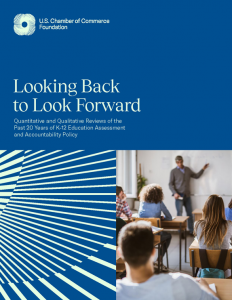 Earlier this year, the U.S. Chamber of Commerce Foundation hosted a webinar to release their new report, The Future of Data, Assessments, and Accountability in K-12 Education, which offers a comprehensive analysis of the landmark education policies of the past two decades, from No Child Left Behind (NCLB) to the Every Student Succeeds Act (ESSA).
Earlier this year, the U.S. Chamber of Commerce Foundation hosted a webinar to release their new report, The Future of Data, Assessments, and Accountability in K-12 Education, which offers a comprehensive analysis of the landmark education policies of the past two decades, from No Child Left Behind (NCLB) to the Every Student Succeeds Act (ESSA).
The event featured a discussion among Maya Martin Cadogan (Founder & Executive Director, Parents Amplifying Voices in Education), Dr. Ivan Duran (Superintendent, Highline Public Schools), Dr. Dan Goldhaber (Director, CALDER American Institutes for Research) and Dr. Chris Steward (Chief Executive Officer, brightbeam), on the report’s findings and future implications for the role of federal policy in the K-12 education system. The panelists also reflected on the perspectives and data they felt were absent from the report and the opportunities to leverage lessons learned.
Key Takeaways
- The reforms of this era were significant because they put in motion new data collection practices that shifted focus to considering the needs of individual student groups.
- The report highlights a binary review of whether reforms have or have not worked over the last 20 years in education reform (i.e., from NCLB to ESSA). Unfortunately, this means that much of the nuance of how states/LEAs impact outcomes were not included in the analysis.
- The federal government has a role in distributing data to states. States and LEAs are responsible for translating this data into information to inform practices that will address the identified gaps in a way that makes sense for their context and communities.
- One lasting legacy of NCLB is that the last 20 years forced schools to disaggregate data and consider the needs of learners, including students of color, students from low-income backgrounds and students with special needs.
- The U.S. educational system still relies on achievement tests to measure students’ and schools’ performance. However, there needs to be more information on other types of assessment to measure student learning and hold schools accountable despite the education community advocating for these changes.
- The authors identified strategies that stakeholders find to have had the most significant impact on building public proficiency in and demand for quality educational opportunities. These include intentional stakeholder buy-in, a compelling and multi-faceted communications strategy and long-term leadership.
Next Steps for State CTE Leaders
As states are considering their next round of Strengthening Career and Technical Education for the 21st Century Act (Perkins V) State Determined Levels of Performance, or perhaps broader changes to Perkins V plans, consider the following actions:
- Visit Careertech.org to subscribe to Advance CTE’s blog newsletter to learn more about our data initiatives and data tools for advancing equity and access in CTE!
- Use Advance CTE’s Inclusive CTE Goal-Setting Tool to further explore equity gaps in data.
- Mine the data collected through your comprehensive local needs assessments (CLNA). A CLNA must be completed by local recipients of Perkins V funds and updated every two years to ensure programs are aligned to workforce needs and economic priorities and serving learners equitably.
- Review the guide from Advance CTE or the recording from the Perkins Collaborative Resource Network to learn more about the CLNA.
- Read about state perspectives and approaches to the CLNA in Lessons in Collaboration and Innovation: The Impact and Promise of the Comprehensive Local Needs Assessment.
- Evaluate what leading indicators your state can develop so data is more timely when making educational decisions.
- Use the Achieving Inclusive CTE Goal-Setting Tool to address and mitigate the opportunities uncovered through the CLNA process.
The full report, Looking Back to Look Forward: Quantitative and Qualitative Reviews of the Past 20 Years of K-12 Education Assessment and Accountability Policy can be found online and through Advance CTE’s Learning that Works Resource Center. You can also find the webinar recording on YouTube.
Dr. Laura Maldonado, Senior Research Associate and Amy Hodge, Policy Associate



